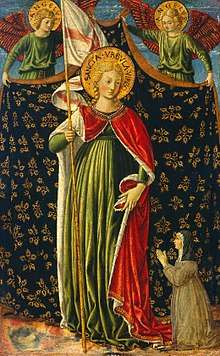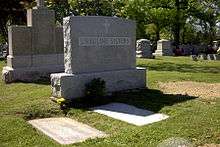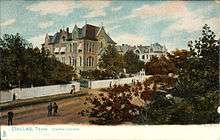Ursulines
The Ursulines, also known as the Order of Saint Ursula (Post-nominals: OSU), is an enclosed religious order of consecrated women that branched off from the Angelines, also known as the Company of Saint Ursula, in 1572. Like the Angelines, they trace their origins to their foundress Saint Angela Merici and place themselves under the patronage of Saint Ursula. While the Ursulines took up a monastic way of life under the Rule of Saint Augustine, the Angelines operate as a secular institute. The largest group within the Ursulines is the Ursulines of the Roman Union.
 | |
| Abbreviation | OSU |
|---|---|
| Named after | Saint Ursula |
| Motto | Soli Deo Gloria (Latin) To God alone give glory (English) |
| Predecessor | Angelines |
| Established | 1572 |
| Founder | Angela Merici |
| Type | Enclosed religious order |
Prioress General | Cecilia Wang |
| Affiliations | Catholic Church |
| Website | No URL found. Please specify a URL here or add one to Wikidata. |

History
In 1572 in Milan, under Saint Charles Borromeo, the Archbishop of Milan, members of the Company of Saint Ursula chose to become an enclosed religious order. Pope Gregory XIII placed them under the Rule of Saint Augustine. Especially in France, groups of the company begin to re-shape themselves as cloistered nuns, under solemn vows, and dedicated to the education of girls within the walls of their monasteries.[1]
In the following century, the Ursuline nuns were strongly encouraged and supported by Saint Francis de Sales. They were called the "Ursuline nuns" as distinct from the "federated Ursulines" of the company, who preferred to follow the original way of life. Both forms of life continued to spread throughout Europe and beyond.[2]
At the beginning of the 18th century, the period of its greatest growth, the order was represented by 20 congregations, 350 convents and from 15,000 to 20,000 nuns.[3][4]
Ursulines in North America
Canada
The Ursuline sisters were not the first Catholic nuns to land in the new world. They were preceded by the Hieronymites in 1585 in Mexico City, who established the convent of San Jerónimo y Santa Paula.[5] In 1639, Mother Marie of the Incarnation, two other Ursuline nuns, and a Jesuit priest left France for a mission to Canada. When they arrived in the summer of 1639, they studied the languages of the native peoples and then began to educate the native children.[6] They taught reading and writing as well as needlework, embroidery, drawing, and other domestic arts.[7][8] The Ursuline convent in Quebec City is the oldest educational institution for women in North America.[9] Their work helped to preserve a religious spirit among the French population and to Christianize native peoples and Métis.
United States
The first Ursulines arrived at Mobile, Alabama, in 1719 (though information is contradictory from remaining and available sources). In 1727, 12 Ursulines from France landed in what is now New Orleans. The entire group of Ursulines were the first Roman Catholic nuns in what is now the United States. Both properties were part of the French colony of Louisiana (New France). They came to the country under the auspices of Pope Pius III and Louis XV of France. Following the Louisiana Purchase in 1803, their charter came under the jurisdiction of the United States.[10]
They instituted a convent and school, both of which continue today.[11] Ursuline Academy (New Orleans) is the oldest continually operating Catholic school in the United States and the oldest girls school in the United States.[12] The Ursuline tradition holds many United States firsts in its dedication to the growth of individuals, including the first female pharmacist, first woman to contribute a book of literary merit, first convent, first free school and first retreat center for ladies, first classes for female slaves (which continued until abolition), free women of color (a unique New Orleans group also known as Creoles of Color) and Native Americans. In the Mississippi Valley region, Ursuline provided the first social welfare center.[13]

The Old Ursuline Convent is located in the Vieux Carre (New Orleans' French Quarter). The building now houses the Archdiocese of New Orleans' Archives as well as operating as a tourist attraction/ museum with public tours available almost daily. They had a well established presence as a hospital by the time of the US Revolutionary War. Ursuline sisters treated in the same building both British and United States soldiers wounded in the war. They may have been the first group of women propagating the ideals of diversity in a society, which flowed directly from the teachings of St Ursula and her followers.
Ursuline nuns, primarily from France and Germany, settled in other parts of North America including Boston (1820), Brown County, Ohio (1845), Cleveland (1850), New York City (1855), Louisville (1858), Chatham, Ontario (1860), and Bruno (1916) and Prelate (1919) in Saskatchewan. These foundations spread to other parts of North America including Toledo, Youngstown, OH, Mount St. Joseph, Kentucky[14] Santa Rosa, Texas, and Mexico City.[15]
Today the monastic Order of St. Ursula (post-nominals OSU) has as its largest group the Ursulines of the Roman Union, described in this article. The other branch is the Company of St. Ursula, commonly called the "Angelines", who follow the original form of life established by their foundress.
The members wore a black dress bound by a leathern girdle, a black sleeveless cloak, and a close-fitting headdress with a white veil and a longer black veil.[16]
Ursulines in Ireland
In 1767, Nano Nagle stayed with the Ursuline Sisters on Rue des Ursulines in Paris while visiting her cousin Margaret Butler who had been professed just one year previously. In 1771, she established the first Ursuline convent in Ireland on Cove Lane in Cork. The community was made up of four Cork women – who were professed at the Ursuline Convent in the Rue St. Jacques in Paris – together with a reverend mother.[17][3] In 1825, the sisters and their boarding students relocated to Blackrock. The first Ursuline primary and second-level schools were founded at Blackrock.[18]
At the request of James Butler, Archbishop of Cashel and Emly, Anastasia Tobin went to Cork to train as a religious. She was professed at the Ursuline convent in September 1787, and returned to Thurles where she commenced teaching. Joined in 1796 by two others also trained at Cork, a small Ursuline community was founded at Thurles. In 1816, four sisters from Thurles established a community in Waterford.[19] In 1932, Providence School was opened to serve the needs of the travelling community.[20]
In 1839, George Joseph Plunket Browne, Bishop of Galway, brought the Ursuline Order of nuns to Dangan on the Oughterard road. In 1844, Browne was translated to the Diocese of Elphin. The Ursulines Order followed him to Elphin, first to Summerhill in Athlone and then to Sligo. He raffled his carriage to raise funds to compensate the sisters for the financial loss they suffered by removing to Sligo. There they took up residence at "Seaville", the former house of Bishop Burke, Browne's predecessor, and renamed it St. Joseph's Convent. Nazareth free primary school was built in 1851.[21]
The Irish Ursuline Union was established in 1978.
Role in education
Colleges and universities
In the United States, the Ursulines have founded two well-known Catholic women's colleges. Ursuline College in Pepper Pike, Ohio, was founded in 1871 by the Ursuline Sisters of Cleveland. It was followed in 1904 by College of New Rochelle, which is located in New Rochelle, New York.
In 1919, the Ursulines founded a university-level liberal arts college for women in London, Ontario, Canada. Currently called Brescia University College (Brescia College at its foundation), it remains the only university-level college for women in Canada and is affiliated with the University of Western Ontario.
From 1922 to 1975 the Mary Manse College in Toledo, Ohio, was operated by the Ursulines. It was a women's college until 1971, then was coeducational for its final four years.
1927, the Ursuline Sisters of the Eastern Province restructured catholic education in Elkton, Maryland by assisting in the founding of Immaculate Conception School, originally located at the corner of Cathedral Street and Singerly Avenue in historic Elkton, Maryland. The Ursulines ministered within the schoolhouse from 1927 to 1930, followed by the Glen Riddle Franciscan Sisters of Saint Francis of Philadelphia.
In 1932, the Great Falls Junior College for Women was founded in Great Falls, Montana. Now the University of Providence, it has an open admission policy.
The Mount Saint Joseph Junior College for Women operated between 1925 and 1950 in Maple Mount, Kentucky, with the Ursulines offering co-educational extension courses at Owensboro. The Ursulines merged their extension courses with Mount Saint Joseph Junior College in 1950, creating the co-educational Brescia University that remains in operation.
In 1966, the Ursulines established in Taiwan what became the Wenzao Ursuline College of Languages.
From 1968 to 2003 the Ursuline Order operated Ursula College at the Australian National University in Canberra, Australia. It is a co-educational residential college for approximately 200 undergraduates. In 2003 the college was sold to the University and was renamed Ursula Hall. The Ursuline tradition has been retained in the Hall's high educational standards, retention of Ursuline symbols and livery, and the observance in October of Ursies Weekend for relaxing and socializing before November exams.
Secondary education

Ursuline secondary education schools are found across the United States and other countries. The first school was Ursuline Academy, began in 1727 in New Orleans, Louisiana. It is the oldest all-girls school in the country. The Academy of Mount St. Ursula High School[22] in the Bronx is the oldest all-girls Catholic high school in New York State, founded in 1855, the same year Sacred Heart Academy in Louisville, Kentucky, was founded.
The Ursuline nuns had been invited to St. Teresa's parish by Rev. James Boyce in 1873 to open a girls’ academy, which was incorporated in 1881 on Henry Street in what is now the Bronx, New York. In 1899 they took possession of a mansion originally built by General Winfield Scott, which he had dubbed, "The Hermitage," and shortly thereafter changed the name of their school from St. Teresa's Ursuline Academy New-York to the Ursuline Academy. In 1905, a news article announced plans for a four-story seminary building to be made for the Convent of St. Theresa on that site by architect Joseph H.McGuire.[23] However, photos show the building unchanged as of 1911.[24] They occupied this building until selling it in 1912, and moving the school to the Ursuline Provinculate at Grand Boulevard and 165th Street.[25]
The Ursuline School in New Rochelle, New York, is a school for girls in grades 6-12 and is closely affiliated with the nearby Iona Preparatory School.
Other notable all-female Ursuline secondary schools in the United States include Ursuline Academy of Dallas, Texas, Ursuline Academy in Saint Louis, Missouri (founded in 1848), and Ursuline Academy in Wilmington, Delaware.
In the London Borough of Newham, United Kingdom, is the all-female girl school St. Angela's, named after the founder of the Ursulines. Only the sixth form centre of the school allows males. The same applies to the Ursuline High School in Wimbledon, which has recently been selected as a Regional Winner - "London Secondary" in the Church School Awards 2011.[26] Ursulines also have St Ursula's Convent School in Greenwich which educates girls aged 11 to 16 and coeducational Ursuline College, Westgate-on-Sea.
The British philosopher and author Celia Green has written extensively about her time at the Ursuline High School (now Ursuline Academy Ilford) in Ilford, London.[27] Angela de Merici inspired the Ursuline Sisters to provide young women with an opportunity to achieve their full potential. Throughout their lives, students continue to remain part of the Ursuline community and continue to carry forward the legacy of Angela de Merici, by serving their society.[28]
There is an Ursuline Convent, in Ranchi, Jharkhand, India.[29]
In Thailand, the Ursulines established Mater Dei School in Bangkok in 1928. Its elite alumni include Kings Ananda Mahidol and Bhumibol Adulyadej.[30] Although an all-girls school, it enrolled boys from Kindergarten through Primary 2.
In Indonesia, the Ursulines established the Princess Juliana School in Batavia (1912), after its initial establishment as an Ursuline Convent in 1859. Now the school is known as St. Ursula Catholic School and is an all-girls school.
Like their colleges, not all Ursuline secondary schools have remained single-sex. Villa Angela Academy, founded in 1878, in Cleveland, Ohio, merged with Marianist (Society of Mary) St. Joseph High School in 1990 forming the coed Villa Angela St. Joseph High School. The aforementioned Ursuline Academy in Delaware permits male students in grades 1–3, and Ursuline High School in Youngstown, Ohio, founded in 1905, is fully co-educational. Other Ursuline secondary schools in the United States include Beaumont School in Cleveland Heights, Ohio (founded in 1850); Ursuline Academy in San Antonio, TX (founded 1851 - closed 1992); Ursuline Academy in Cincinnati, Ohio (founded in 1898); St. Ursula Academy in Cincinnati, Ohio; the Ursuline Academy of Dedham in Dedham, Massachusetts; Ursuline High School in Santa Rosa, California (founded in 1880); Ursuline Academy in Springfield, Illinois (founded 1857), which was coed from 1981 until it closed in 2007; and St. Joseph's Ursuline Academy in Malone, New York (closed in 1977 and was coed at least from the mid-1960s). There are Ursuline secondary schools in Ireland in Thurles, County Tipperary; Waterford, Blackrock, County Cork; and Sligo, Ireland, which have remained single sex.
See also
- Congregation of the Ursulines of the Agonizing Heart of Jesus (Grey Ursulines)
- École des Ursulines, Quebec
- Dorothy Kazel
- Society of the Sisters of Saint Ursula of the Blessed Virgin
- Ursuline Convent Riots
- Ursulines of Quebec (includes Ursulines museum)
- Ursuline Sisters Daughters of Mary Immaculate
Notes
- "The Company of St. Ursula". Ursulines of the Roman Union. Archived from the original on 19 July 2013. Retrieved 16 January 2013.
- "Our History". The Company of St. Ursula in the United States. Archived from the original on 8 May 2012. Retrieved 16 January 2013.
- Chisholm, Hugh, ed. (1911). . Encyclopædia Britannica. 27 (11th ed.). Cambridge University Press. p. 804.
- Collier's New Encyclopedia: A Loose-leaf and Self-revising Reference Work; with Illustrations and Ninety-six Maps. Google Books: Collier. 1921. pp. 140–141.
- Lavrin, Asunción (2008). Brides of Christ: Conventual Life in Colonial Mexico. Stanford: Stanford University Press. p. 259.
- Buescher, John. "Religious Orders of Women in New France", Teachinghistory.org, accessed August 21, 2011
- Chabot, Marie-Emmanuel (1979) [1966]. "Guyart, Marie, dite Marie de l'Incarnation". In Brown, George Williams (ed.). Dictionary of Canadian Biography. I (1000–1700) (online ed.). University of Toronto Press.
- Agnes Repplier, Mère Marie of the Ursulines: a study in adventure (New York, 1931)
- Fidelis, Mother Mary (1912). . In Herbermann, Charles (ed.). Catholic Encyclopedia. 15. New York: Robert Appleton Company.
- Dom Guy-Marie Oury, Les Ursulines de Québec, 1639-1953 (2000)
- "Ursuline Academy and Convent in New Orleans Before and After Hurricane Katrina Photo Gallery by Coleen Perilloux Landry at". Pbase.com. Retrieved 2012-08-04.
- "Ursuline Academy and Convent in New Orleans Before and After Hurricane Katrina by Coleen Perilloux Landry". PBase. Retrieved 2016-06-02.
- "Ursuline Heritage | Ursuline Academy". www.uanola.org. Retrieved 2016-06-02.
- Ursuline Sisters of Mount Saint Joseph
- "Follow the Spirit." Angela Merici and the Ursulines. Editions du Signe. Rome: Spada, 1998
- Eaton, Andi (2014). New Orleans Style. Google Books: The History Press. p. 52. ISBN 1626196419.
- Clarke, Sr M. Ursula. The Ursulines in Cork since 1771 (Cork: Ursuline Convent, 2007) ISBN 978-0-9528160-0-3
- "Ursuline Education in Ireland", St. Ursula's Primary School
- "History of the Ursuline Sisters in Waterford", St. Angela's School, Waterford
- "Ursulines Thurles", Sisters of the Irish Ursuline Union
- "History Of The School", Ursuline College Sligo
- "Academy of Mount Saint Ursula". Amsu.org. 2010-08-14. Retrieved 2012-08-04.
- "New Home For Ursuline Convent" (PDF). New York Daily Tribune. July 9, 1905. Retrieved May 7, 2019.
- "(still image) Manhattan: Park Avenue - 93rd Street, (1911)". |author=Digital Collections, The New York Public Library |accessdate=May 7, 2019 |publisher=The New York Public Library, Astor, Lennox, and Tilden Foundation}}
- Miller, Tom (2013-04-01). "Daytonian in Manhattan: The Lost 1847 Winfield Scott Mansion -- 93rd and Park Avenue". Daytonian in Manhattan. Retrieved 2019-05-07.
- "London Secondary | Church Schools Awards". Churchschoolawards.com. 2012-06-28. Retrieved 2012-08-04.
- Green, Celia (2004). Letters from Exile: Observations on a Culture in Decline. Oxford: Oxford Forum.
- UrsulineAcademyMA. "The Ursuline Sisters - Carrying forth The Legacy of St. Angela de Merici". YouTube. Retrieved 2012-08-04.
- "Welcome to Ursuline Intermediate College!!". uicranchi.com. Retrieved 2017-06-20.
- The History of Mater Dei School Archived 2013-02-07 at the Wayback Machine
Further reading
- Agnes Repplier. Mère Marie of the Ursulines: a study in adventure (New York, 1931), on Canada to 1672
- Dom Guy-Marie Oury. Les Ursulines de Québec, 1639-1953 (2000)
- Querciolo Mazzonis, "A female idea of religious perfection: Angela Merici and the Company of St Ursula (1535-1540)," Renaissance Studies, 18,3 (2004), 391–411.
- Emily Clark (ed), Voices from an American Convent: Marie Madeleine Hachard and the New Orleans Ursulines, 1727-1760 (Baton Rouge, Louisiana State University Press, 2007).
- Q. Mazzonis, "The Impact of Renaissance Gender-Related Notions on the Female Experience of the Sacred: The Case of Angela Merici's Ursulines," in Laurence Lux-Sterritt and Carmen Mangion (eds), Gender, Catholicism and Spirituality: Women and the Roman Catholic Church in Britain and Europe, 1200-1900 (Basingstoke, Palgrave Macmillan, 2011),
- Lierheimer, Linda.
External links
- Congregation of the Ursuline Sisters, Onze-Lieve-Vrouw-Waver in ODIS - Online Database for Intermediary Structures
- Archives of the Congregation of the Ursuline Sisters, Onze-Lieve-Vrouw-Waver in ODIS - Online Database for Intermediary Structures
- Congregation of the Ursuline Sisters, Tildonk in ODIS - Online Database for Intermediary Structures
| Wikimedia Commons has media related to Ursulines. |
- Ursulines of the Roman Union
- General Chapter of Ursulines of the Roman Union
- Ursulines of the Roman Union - Centro studi internazionali
- Sisters of the Irish Ursuline Union
- Ursulines United Kingdom
- Australian Ursulines
- The Ursuline convent in Beaugency France
- Ursulines of the United States
- The Ursulines of Youngstown, Ohio
- Ursuline Sisters of the Cincinnati
- Ursuline Sisters St. Louis, MO
- Ursulines of the Eastern Province
- Ursulines of Indonesia
- Works by An Anonymous Ursuline at Project Gutenberg
